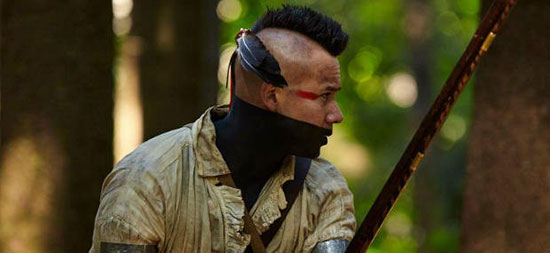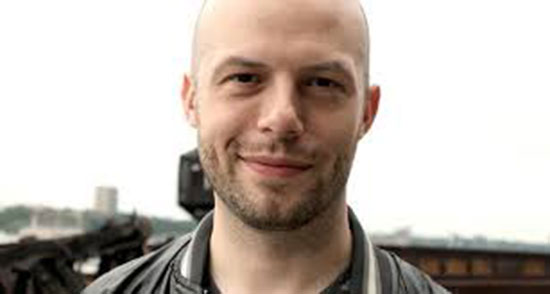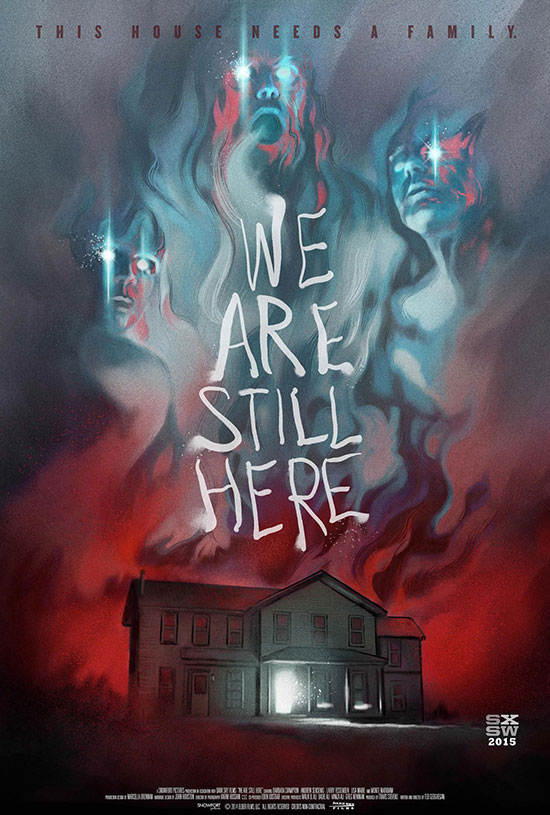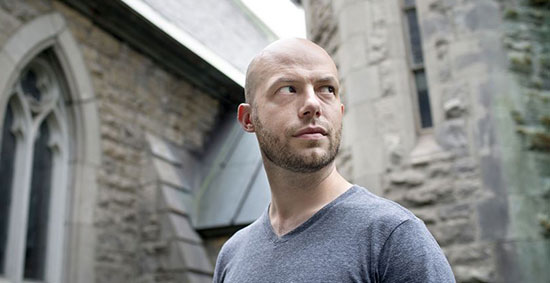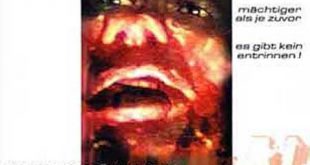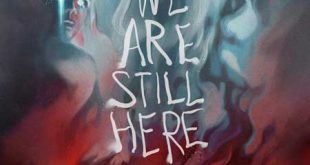We Are Still Here was a surprise hit of the indie horror scene in which debuted in 2015. It was a ghost story at its core but had so many more secrets, including a Reservoir Dogs style brutal supernatural cliffhanger. It had won many fans over and was critically praised, insta ntly making the man behind the camera one to look out for in the horror genre. But Ted Geoghegan did not have the desire to stay firmly planted in one place. He wanted to tell all of the stories he wanted to tell and transcend the genre even though he absolutely adores it. Which brings us to his latest historical drama which is now playing at the Fantasia International Film Festival, Mohawk. I had a chance to sit down with Ted and talk about the new project, its supernatural and horror elements, and his decision to attempt a brand new tale in an entirely different realm of filmmaking.
ntly making the man behind the camera one to look out for in the horror genre. But Ted Geoghegan did not have the desire to stay firmly planted in one place. He wanted to tell all of the stories he wanted to tell and transcend the genre even though he absolutely adores it. Which brings us to his latest historical drama which is now playing at the Fantasia International Film Festival, Mohawk. I had a chance to sit down with Ted and talk about the new project, its supernatural and horror elements, and his decision to attempt a brand new tale in an entirely different realm of filmmaking.
HNN: Ted, thank you for having this sit down with me and for success on another great film. It is quite a bit of a departure from We Are Still Here but tell the readers a bit about your latest Mohawk?
Ted: The plot of Mohawk involves three lovers which consists of a Mohawk woman and man, as well as an English soldier who have formed an unconventional bond together toward the end of the War of 1812. After being tired of seeing his tribe become New Americans the young Mohawk man burns down an encampment, thinking he has killed everyone, although eight survive the blaze and give chase when it comes to the group. It’s a dark drama about the futility of war and how things really do not change over the course of two hundred years. It’s a movie about marginalized people getting f**** over and the white mans’ misunderstanding of the fact that they are the villains. It plays on the blindness when it comes to their hatred and ultimately puts them on the wrong side of history.
HNN: The more things change, the more things stay the same.
Ted: Exactly.
HNN: After doing a film that was completely rooted in the horror genre, what inspired you to take such a sharp turn into historical non-fiction territory?
Ted: Well, I can definitely tell you that while the events in Mohawk are historic, the contents of the film is very much fiction. It’s a fictionalized account and has very strong genre elements. Without giving too much away it’s almost surreal, abstract, and has these almost supernatural elements throughout. When I had set out to do it I wanted to make something that was important to me. I’m not saying that We Are Still Here wasn’t, but with my directorial debut I wanted to show audiences what I saw as a lost horror film from the late seventies. With Mohawk I wanted to make a film that focused on things that were important to me when I was watching the world changing over the past two years. When I had discovered the Mohawk people and what they had brought to my hometown city of New York and history in general, I always held them with great reverence. I had learned that they had gone so much and I thought it was a great story to tell, especially in our changing times where people are still marginalized and idiots going out of their way to make their lives even more difficult. As a man of European heritage, I wanted to tell a story that things haven’t changed and things need to change. Sadly we know what happened to the Native American people. These people had been pushed back almost to the point of extinction, and as a white man I wanted to see more of these varied voices in cinema.
HNN: It seems to me that you are also a bit of a historical buff. Even with We Are Still Here there was a bit of history within the house and the inhabitants thereof. Were you always fascinated with history?
Ted: I would say so. Yeah. My father was a professor of American history. I always grew up around someone who loved to learn about the birth of our country. I grew up in rural Montana, and my life was always rooted in the history of small towns. When I had moved to New York I had a lot of interest in small New England communities, or for lack of a better term Lovecraft Country. I had interest in these sleepy little towns that were darker than what they let on. I think it speaks of America as a whole, that it is beautiful, but when you dig deep it is really ugly. We Are Still Here and Mohawk deal with those concepts, those of our fathers in a way. We Are Still Here involved a story where something had happened hundreds of years before and people still paid the price. People are almost forced to face and become evil to combat something created by our forefathers, where Mohawk is about those forefathers in a way. I’m not saying it’s in the same universe but they go hand in hand in a way. I could easily make a story where a darkness is awoken and have it be the same.
HNN: How much of your own research was placed into the film when it comes to the history and the narrative?
Ted: Oh yeah, there was a lot. I felt that I owed so much to the people that I am telling the stories of, that I am faithful to them. I had the pleasure of working with a brilliant writer on the screenplay whose name is Grady Hendrix. Grady and I had been friends and worked together for decades, but he is a huge War of 1812 buff, and when I told him I was writing a film based on that period he was ecstatic and at first I didn’t believe that he loved the period as much as he said he did. But when I went to a meeting at his house he had a large number of books based on that piece of history and I knew he wasn’t pulling my leg. He was so integral in kicking off the project and making sure that we were writing something as historically accurate as possible. When we were comfortable with the script and began casting we went straight to an actor named Kaniehtiio Horn. We reached out to her and said she was perfect, and she told us that if you hire someone else for this I will kill you (Laughs). She brought so much to the project in the sense that she grew up on a Mohawk reservation and her family spoke the language. We were able to insert into the film. These were things we never thought we could do, but in terms of the little things she could add to the film it was so powerful to have her be part of the cast. She told us what we should do and what we shouldn’t do, and she went to her family and got their feedback and came back with so much to make the film as loving and authentic to the Mohawk people as possible. It was incredible. We wanted the Mohawk people to be proud of the movie and to show their strengths.
HNN: When you shot the movie and even though it is not particularly in the same period, did you take any cues from any historical projects, possibly even Westerns?
Ted: No, I don’t think I took any cues from any Westerns, but if I did it would be from the Italian Spaghetti Westerns like Django. There could be a little bit of that somewhere.
HNN: When you had come up with the concept of Mohawk, was it your mission to maybe add a few horror elements or did the history stand up for itself in regard to the terror of what life once was?
Ted: It’s a horrifying time in history where the film is set, and the moments within that period were very dark and extremely bleak. With that said, we did go out of our way to make sure there were a few genre elements or horror beats. This isn’t just a film about man’s inhumanity to man, there is some horror moments that will hopefully satisfy fans. It’s bloody but I would never call Mohawk a horror film, I’m extremely proud to call it a historic drama.
HNN: Well, I am really happy to finally talk to you. I absolutely loved We Are Still Here and Mohawk, and I am so happy to see you taking all the different corners that you want to take in your career. I think it’s excellent that you’re not painting yourself in one corner. So thank you for speaking with me.
Ted: Thank you. I am always happy to speak with someone who gets or has been touched by my work. It really keeps me going and wakes me up in the morning, so this means a lot for me, you have no idea.
 Horror News | HNN Official Site | Horror Movies,Trailers, Reviews
Horror News | HNN Official Site | Horror Movies,Trailers, Reviews
